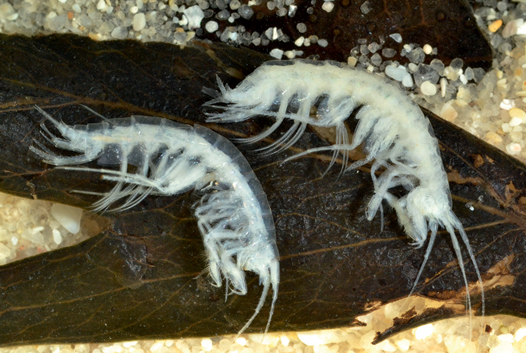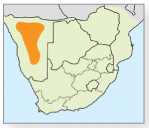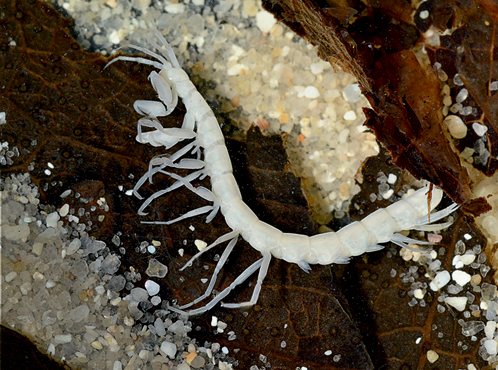
19 |
Text by Charles Griffiths |
|---|---|
A diverse group of smaller crustaceans, largely characterised by the presence of a ventral brood pouch or ‘marsupium’ in females, from which fully developed young emerge.
Amphipods
Order Amphipoda
Small (body 5–25mm in length) shrimp-like crustaceans, typically with the body laterally compressed. Head with two pairs of elongate antennae; thorax of seven segments, each with a pair of walking legs, the first two of which end in nippers. Abdomen of six segments, each bearing branched ventral appendages, ending in a tail flap (telson). Most feed on detritus. Primarily a marine group, but locally common in fresh water; rarely terrestrial. Freshwater fauna of southern Africa comprises some 40 species, divided into three taxonomically and geographically distinct groups.
1 Leaf-shredder amphipod
Paramelita capensis


© C. GRIFFITHS

© C. GRIFFITHS

© C. GRIFFITHS

© C. GRIFFITHS

© C. GRIFFITHS
Eyes white (often invisible when preserved), antennae long and unmodified, second pair shorter than first, lacking teeth, lobes or ridges. Second pair of nippers larger than first. Telson divided into two lobes. Size: Body 15mm in length. Biology: Restricted mainly to headwaters of streams, where often abundant, swarming over and skeletonising leaf litter (1a). Sensitive to disturbance and seldom occur below human habitation. RELATED SPECIES: One of 26 species from the endemic family Paramelitidae, found in streams, wetlands and caves throughout the Western Cape. P. nigroculus (1b) is common from the Cederberg to Swellendam and is the only species of Paramelita with black eyes. P. magna (1c) is among the largest species, reaching 22mm in length, and is a Cape Peninsula endemic, recognised by its greatly enlarged second antennae. Members of the closely related genus Aquadulcaris (1d) are generally smaller (<10mm in length), with shorter, inflated or lobed second antennae, and are mostly restricted to smaller seeps and springs.
2 Cave amphipods
Sternophysinx species


© C. GRIFFITHS
Distinguished from Paramelitids (see 1, above) by their geographical range, by having second nipper smaller than the first and by having an entire or notched, but not divided, telson. Eight species in the region. Size: Body 5–15mm in length. Biology: Confined to pools in caves, rarely reported in surface springs. Most have very restricted distributions; some caves support two species in the same small pool. Thought to feed on bat guano.
3 Slender cave amphipods
Family Ingolfiellidae


© C. GRIFFITHS
Blind, cave- and groundwater-dwelling amphipods, with unusually elongated, cylindrical bodies and greatly reduced abdominal appendages. Size: Body up to 25mm in length. Biology: Poorly known. Six species and three genera recorded from the region, each known from only a few samples, sometimes from just a single cave or borehole. Although not formally recorded from South Africa, an undescribed member of this group has been observed in a cave in the Northern Cape. Probably feed on bat guano, microorganisms and plant debris falling into the pools. Brood plates reduced, suggesting that eggs are not carried by females, but are deposited in the mud.
Isopods
Order Isopoda
Small crustaceans with body usually flattened, rarely cylindrical. Seven thoracic segments each bear a pair of legs, the first often with nippers. Six abdominal segments, of which some may be fused with the terminal telson, forming a pleotelson (false telson). Diverse in marine and estuarine systems, and on land (woodlice), but uncommon in fresh water. About 15 true freshwater species occur in the region, most of them minute and highly localised.
4 Friartucks
Mesamphisopus species


© C. GRIFFITHS
Body robust, brown, not flattened (unusual among isopods). First antennae much shorter than second pair; first pair of legs with nippers; last abdominal segment fused with telson, forming a domed pleotelson. Size: Body reaching 15mm in length. Biology: Ten closely related species known, all endemic and many recently described. Most restricted to mountain streams in the southwestern Cape, but a few on coastal lowlands. Biology poorly known; thought to be algal deposit feeders.